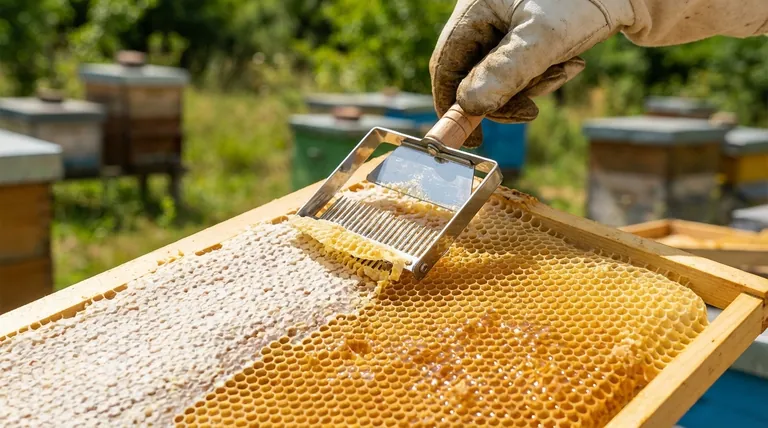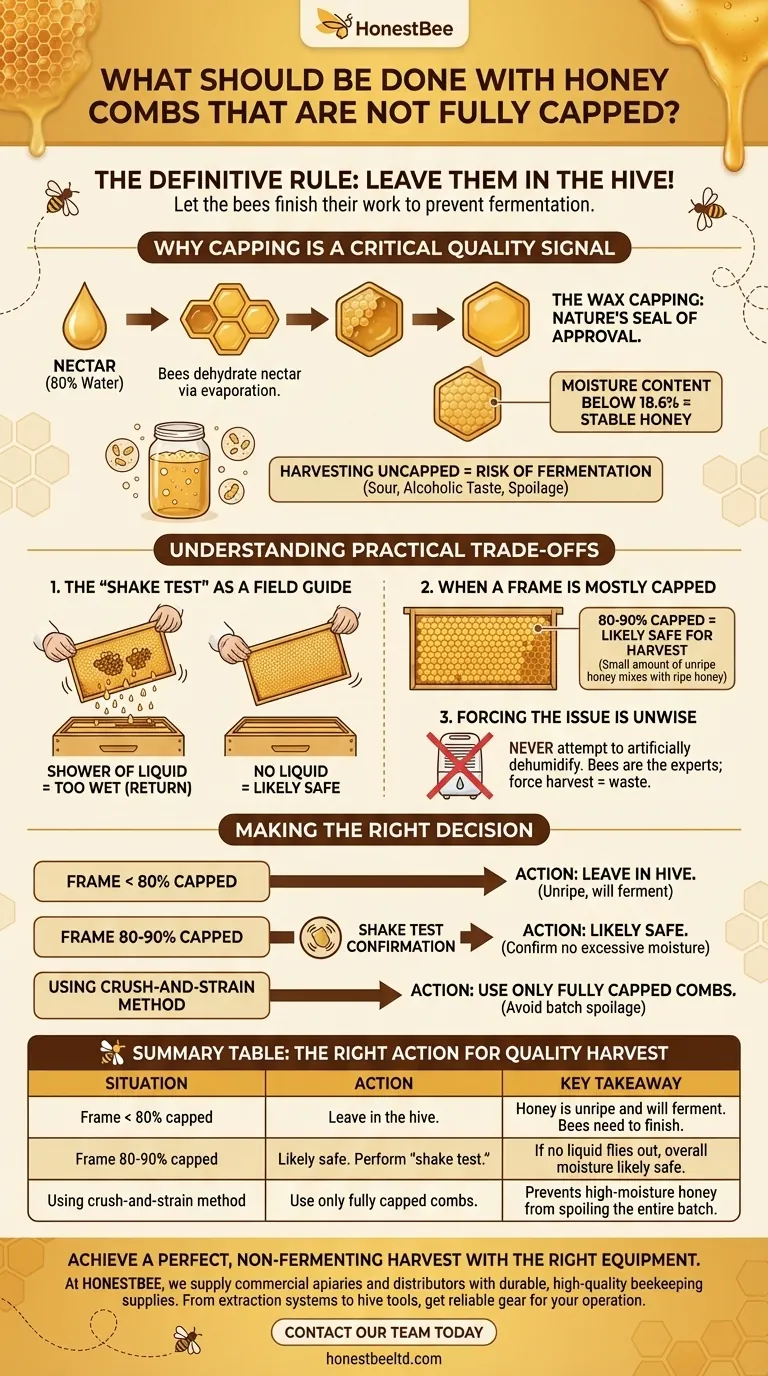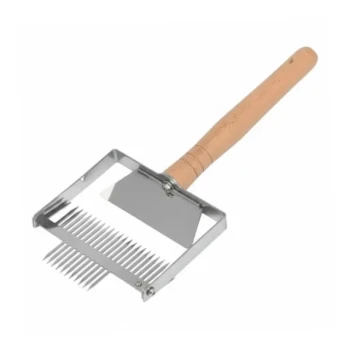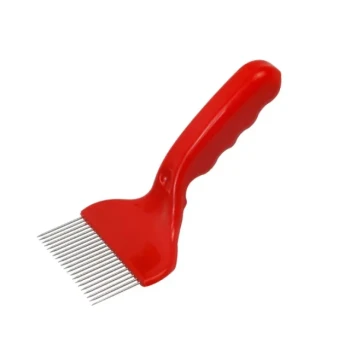The definitive rule for honeycombs that are not fully capped is to leave them in the hive for the bees to finish their work. This is not just a suggestion but a fundamental principle of beekeeping. Extracting this "unripe" honey is a critical error because the bees have not yet dehydrated it to the proper moisture content, making it almost certain to ferment and spoil.
The wax capping on a honeycomb is nature's seal of approval. It signifies that the bees have reduced the honey's moisture content to a stable level (below 18.6%), ensuring it will not ferment and can be stored indefinitely. Harvesting uncapped honey undermines this natural process.

Why Capping is a Critical Quality Signal
To understand the importance of a capped honeycomb, you must first understand how honey is made. It's a process of transformation, and the final step is the most crucial for long-term storage.
The Role of Moisture Content
Nectar, the raw material for honey, is about 80% water. The bees' primary job is to dehydrate this nectar.
They achieve this by passing it from bee to bee and fanning their wings over the open cells, creating an evaporative airflow. Their goal is to reduce the water content to a precise level, typically between 17-18%.
Wax Capping as a Seal of Approval
Once the honey reaches this ideal moisture level, it is considered "ripe." The low water content makes the honey a hostile environment for the yeasts and microbes that cause spoilage.
To protect their finished product, the bees secrete a fresh wax seal over the top of the cell. This cap is airtight and waterproof, locking in the quality and preventing the honey from reabsorbing moisture from the air.
The Inevitable Risk of Fermentation
Extracting honey before it's capped means you are harvesting a product with excess water. This high moisture content allows naturally occurring yeasts within the honey to activate and multiply.
The result is fermentation. The honey will develop a sour, alcoholic taste, become bubbly, and is considered spoiled. It cannot be sold or stored and is a complete waste of the bees' hard work.
Understanding the Practical Trade-offs
While the rule is to wait for cappings, experienced beekeepers operate with a degree of informed flexibility. Not every frame will be 100% perfect.
The "Shake Test" as a Field Guide
A reliable field test for moisture is the "shake test." Hold the frame horizontally over the top of the hive and give it a firm, downward shake.
If no nectar or honey flies out, the moisture content is likely low enough for a safe harvest, even if a few cells remain uncapped. If you see a shower of liquid, the honey is far too wet and must be returned to the bees.
When a Frame is Mostly Capped
It is a common and generally accepted practice to harvest frames that are at least 80-90% capped.
The small amount of unripe honey in the few uncapped cells will be mixed with the large volume of ripe, low-moisture honey. This typically results in an overall moisture level that is still within the safe range for storage.
Forcing the Issue is Unwise
Never attempt to "finish" the honey yourself by using a dehumidifier or other means. This is an unreliable process that rarely works as intended and can introduce contaminants.
The bees are the ultimate experts. Patience is the beekeeper's most valuable tool in this scenario. Forcing a harvest before the colony is ready benefits no one.
Making the Right Decision for Your Harvest
Your decision should always prioritize the long-term quality of your honey and the health of the colony. The bees need these stores as much as you do.
- If your frame is less than 80% capped: Leave it in the hive. There is no debate here; the honey is not ready, and the colony still needs to work on it.
- If your frame is 80-90% capped: It is likely safe to harvest. Use the "shake test" to confirm the uncapped portions are not excessively wet.
- If you are using a crush-and-strain method: You must be even more diligent. Since this method mixes everything together, ensure you only use fully capped combs to avoid contaminating the entire batch with high-moisture honey.
Trusting the bees' signal—the pristine white wax cap—is the surest path to a perfect honey harvest and a healthy, thriving colony.
Summary Table:
| Situation | Action | Key Takeaway |
|---|---|---|
| Frame is < 80% capped | Leave in the hive. | Honey is unripe and will ferment. The bees need to finish their work. |
| Frame is 80-90% capped | Likely safe to harvest. Perform the "shake test." | If no liquid flies out, the overall moisture content is likely safe. |
| Using crush-and-strain method | Use only fully capped combs. | Prevents high-moisture honey from spoiling the entire batch. |
Achieve a perfect, non-fermenting harvest with the right equipment.
At HONESTBEE, we supply commercial apiaries and distributors with the durable, high-quality beekeeping supplies needed to support healthy colonies and successful harvests. From extraction systems to hive tools, our wholesale-focused operations ensure you get the reliable gear your operation depends on.
Contact our team today to discuss your equipment needs and learn how we can support your beekeeping success.
Visual Guide

Related Products
- Stainless Steel Double Sided Honey Uncapping Fork with Scraper
- Automatic Honey Frame Uncapper Machine for Beekeeping
- Professional Wide Head Honey Uncapping Fork for Beekeeping
- Professional Durable Plastic Handle Honey Uncapping Fork
- Extra-Wide All-Stainless Steel Honey Uncapping Fork with T-Handle
People Also Ask
- How does a honey uncapping fork supplement the use of an uncapping knife? Boost Your Honey Yield and Extraction Efficiency
- What other tools are available for honey uncapping besides knives? Find the Right Tool for Your Apiary's Scale
- What makes polyurethane foam environmentally friendly? The Surprising Benefits of a Durable, Inert Material
- Why are my bees not capping honey? Understand the Key to Perfect Honey Ripening
- What tools are available for uncapping honey? A Guide to Choosing the Right Tool for Your Operation



















